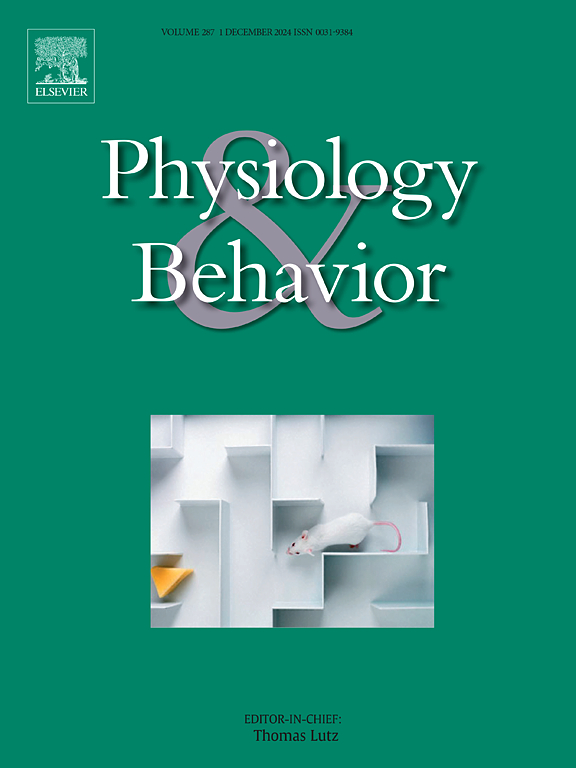URB597 modulates neuroplasticity, neuroinflammatory, and Nrf2/HO-1 signaling pathways in the hippocampus and prefrontal cortex of male and female rats in a stress-induced model of depression
IF 2.4
3区 医学
Q2 BEHAVIORAL SCIENCES
引用次数: 0
Abstract
Major depressive disorder is often associated with cognitive impairments, and neuroinflammation is considered a key contributor to the onset of depression. Pharmacological inhibition of fatty acid amide hydrolase (FAAH), which augments endocannabinoid signaling, has emerged as a promising approach to treating depression. The main purpose of this study is to asses the influence of FAAH inhibitor URB597 on inflammatory response and oxidative stress in chronic unpredictable stress (CUS)-induced depressive female and male rats and to explore the underlying molecular mechanisms. Chronically stressed animals showed long-term memory deficits, while URB597 improved memory only in stressed males. URB597 treatment enhanced levels of brain-derived neurotrophic factor (BDNF) in the hippocampus and mPFC of stressed female and male rats and increased phosphorylated calcium/calmodulin-dependent protein kinase II (pCaMKII) levels in the hippocampus and mPFC of CUS males. Additionally, increased phosphorylation of JAK2 and STAT3 in the hippocampus and mPFC of CUS male and female rats, was reduced following URB597 treatment. URB597 decreased the CUS-enhanced iNOS protein expression in the hippocampus and mPFC of both sexes. Furthermore, URB597 normalized CUS-induced reductions in Nrf2 and HO-1 levels in the mPFC of both sexes, with no changes in the hippocampus. Our findings suggest that URB597 may inhibit the CUS-induced neuroinflammatory response by suppressing the pro-inflammatory mediators and the activation of the JAK2/STAT3 signaling in the hippocampus and mPFC of both sexes. URB597 treatment contributed to synaptic plasticity in a sex-specific manner by upregulating brain CaMKII signaling in males. URB597 also exerts neuroprotective effects through region-specific antioxidant properties. These results have implications for sex-specific treatment strategies in stress-related neuropsychiatric disorders.

应激性抑郁大鼠海马和前额叶皮层神经可塑性、神经炎症和Nrf2/HO-1信号通路的调控
重度抑郁症通常与认知障碍有关,神经炎症被认为是抑郁症发病的关键因素。脂肪酸酰胺水解酶(FAAH)的药理抑制,增加内源性大麻素信号,已成为治疗抑郁症的一种有前途的方法。本研究的主要目的是评估FAAH抑制剂URB597对慢性不可预知应激(CUS)诱导的抑郁大鼠炎症反应和氧化应激的影响,并探讨其潜在的分子机制。长期应激动物表现出长期记忆缺陷,而URB597仅在应激雄性动物中改善记忆。URB597处理提高应激雌性和雄性大鼠海马和mPFC中的脑源性神经营养因子(BDNF)水平,增加应激雄性大鼠海马和mPFC中的磷酸化钙/钙调素依赖性蛋白激酶II (pCaMKII)水平。此外,在URB597处理后,CUS雄性和雌性大鼠海马和mPFC中JAK2和STAT3磷酸化的增加减少。URB597降低了cuss增强的海马和两性mPFC中iNOS蛋白的表达。此外,URB597使cuss诱导的两性mPFC中Nrf2和HO-1水平的降低正常化,而海马中没有变化。我们的研究结果表明,URB597可能通过抑制促炎介质和海马和mPFC中JAK2/STAT3信号的激活来抑制cus诱导的神经炎症反应。URB597处理通过上调雄性大脑CaMKII信号通路,以性别特异性的方式促进突触可塑性。URB597还通过区域特异性抗氧化特性发挥神经保护作用。这些结果对压力相关神经精神疾病的性别特异性治疗策略具有启示意义。
本文章由计算机程序翻译,如有差异,请以英文原文为准。
求助全文
约1分钟内获得全文
求助全文
来源期刊

Physiology & Behavior
医学-行为科学
CiteScore
5.70
自引率
3.40%
发文量
274
审稿时长
47 days
期刊介绍:
Physiology & Behavior is aimed at the causal physiological mechanisms of behavior and its modulation by environmental factors. The journal invites original reports in the broad area of behavioral and cognitive neuroscience, in which at least one variable is physiological and the primary emphasis and theoretical context are behavioral. The range of subjects includes behavioral neuroendocrinology, psychoneuroimmunology, learning and memory, ingestion, social behavior, and studies related to the mechanisms of psychopathology. Contemporary reviews and theoretical articles are welcomed and the Editors invite such proposals from interested authors.
 求助内容:
求助内容: 应助结果提醒方式:
应助结果提醒方式:


